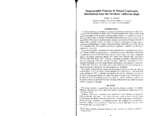- DSpace Home
- →
- Channel Islands
- →
- National Park Service
- →
- California Islands Symposia Documents
- →
- 2nd California Islands Multidisciplinary Symposium
JavaScript is disabled for your browser. Some features of this site may not work without it.
| dc.contributor.author | Kanter, Robert G. | en |
| dc.date.accessioned | 2010-04-05T22:24:11Z | en |
| dc.date.available | 2010-04-05T22:24:11Z | en |
| dc.date.issued | 1980 | en |
| dc.identifier.citation | Kanter, Robert G. "Biogeographic Patterns in Mussel Community Distribution from the Southern California Bight." In: 2nd California Islands Multidisciplinary Symposium. 1978. 341-355. | en |
| dc.identifier.uri | http://hdl.handle.net/10139/1096 | en |
| dc.description.abstract | The diverse assemblage of organisms associated with Mytilus californianus Conrad (Mollusca: Bivalvia) populations is a useful tool for examining biogeographic patterns of intertidal species distributions in the Southern California Bight. Mussels, as members of the genus Mytilus are often called, are attached to the underlying substrate and to other mussels by strong byssal threads. This mode of attachment enables mussels to form layered beds up to 20 cm thick (Paine 1976). Sediment, detritus, and debris are trapped in the spaces between mussels, providing food and shelter for a variety of other invertebrates (Reish 1964, Paine 1966, Kanter 1977, Suchanek 1979). This complex association of organisms is referred to as the Mytilus californianus community. The mussel community is extremely rich, often supporting several hundred species (Kanter 1977, Suchanek 1979); its species richness is rivaled only by that of the Balanus-Endocladia association described by Glynn (1965). Past studies of mussel beds have dealt only with specific questions concerning succession (Hewatt 1937, Reish 1964, Cimberg 1975) and trophic structure (Paine 1966, Kanter 1977). Questions concerning community distribution patterns over major geographic areas have not been addressed. Large-scale investigations of other intertidal communities have concentrated on macro-invertebrates, macrophytes, or both (Dawson 1959, 1965, Nicholson and Cimberg 1971, Littler 1980); the micro-biota occupying interstices in algal turf and mussel beds were generally not considered. The Southern California Bight contains intertidal mussel beds at mainland and offshore island localities. Prior to the Bureau of Land Management's (BLM) Outer Continental Shelf studies initiated in 1975, no detailed investigations into mussel community structure or distribution had been performed in the bight. This paper discusses some of the findings of the third-year (1977-1978) BLM program, including: (1) mussel community composition, (2) mussel community species richness, and (3) biogeographic patterns and similarities among mussel communities of the bight. | en |
| dc.language.iso | en_US | en |
| dc.publisher | National Park Service | en |
| dc.subject | mussel | en |
| dc.subject | southern california bight | en |
| dc.subject | bivalve | en |
| dc.subject | mollusca | en |
| dc.subject | distribution | en |
| dc.title | Biogeographic Patterns in Mussel Community Distribution from the Southern California Bight | en |
| dc.type | Article | en |

